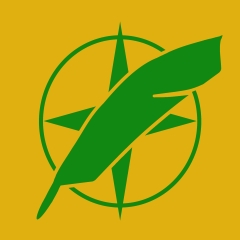
Have a great trip!
May 29, 2019
Bike touring sounds as simple as "Just go ride," but there's a lot of preparation to be done before that happens.
For one, you need a bike! This wouldn't normally be a problem for me, but the route I had in mind necessitated a type of bike I don't have.
Last summer, while hiking the Pacific Crest Trail, I took a day off and stayed with a host family in Lake Tahoe, CA. I noticed they had a few mountain bikes in their garage, and there was a trail system in the woods only a couple blocks away. I'd wanted to try a 27.5" bike, so I asked, and they said it'd be fine if I took one out for a ride.
The mountain bikes I've had in the past were either 26" or 29". Each size has its strengths and weaknesses, and as you might imagine, 27.5" is a compromise between the two. Within minutes, I was in love. I gotta get me one of these!
I had a specific model in mind, almost entirely due to its unusually large main triangle, which would allow you to pack a fair amount of your stuff in a frame bag in the center of the bike. No matter the quality of the bike, a balanced bike rides better. But I decided instead to order parts and build a bike from the frame out. If I did it wisely, I could save a little money (doing this is usually more expensive, not less), and I'd have greater control over all the parts.
After some hiccups along the way, I wound up with Teeder, a surprisingly lightweight, capable machine with beefy tires. Some mountain bikes are like a monster truck, some are more like pickups, and others are more like SUVs. Teeder is more like a Jeep, after putting huge off-road tires on it.

Along with the bike itself, I get a set of bikepacking bags. Racks and panniers don't do so well off-road, because they're not meant for bouncing. Also, most mountain bikes don't have eyelets for mounting a rack.
Bikepacking bags are simply canvas bags with velcro straps that allow you to fasten them to the bike frame. Compared to panniers, they have much less capacity, which means you have to pack not light, but small. The nice thing about a bikepacking setup is it's much lighter, as there's a lot less hardware, and also more streamlined. The aerodynamic benefit alone means it takes 12% less energy to maintain the same speed, and that's not even taking the weight difference into account. I might start using this setup on all my bike tours.
So what is all this in preparation for? The Wild West Route!
Months ago, I'd conceived of a route in the western states that would stitch together the Arizona Trail, the White Rim Loop in Utah, and the Trail of the Coeur d'Alenes in Idaho. The route would start in Tucson and end in Seattle, simply because those are places you can get to and from easily.

Less than a month before departure, I found out about the Wild West Route, a new bikepacking route created in essentially the exact same areas I'd intended on riding. It stays on dirt roads 80% of the time, it's been test-ridden, and there's oodles of data about where you can find water and resupply on food. Perfect!
I'm making a few detours (mostly to ride the White Rim Loop and Trail of the Coeur d'Alenes), but for the most part, that's what I'm doing.
Got the bike. Got the gear. Got the route. All set!
Four days before departure, my rear hub exploded.

Read about Coyote's adventure with his father in Central Texas. Music, food, wheels, family, all the finer things in life.
 2006
2006
 June
June
 July
July
 August
August
 2007
2007
 February
February
 2008
2008
 October
October
 November
November
 December
December
 2009
2009
 January
January
 February
February
 April
April
 June
June
 Lampasas, TX
Lampasas, TX
 Lake Whitney State Park, TX
Lake Whitney State Park, TX
 Cedar Hill State Park, TX
Cedar Hill State Park, TX
 Plano, TX
Plano, TX
 Denton, TX
Denton, TX
 Archer City, TX
Archer City, TX
 Quanah, TX
Quanah, TX
 Clarendon, TX
Clarendon, TX
 Palo Duro Canyon and Amarillo, TX
Palo Duro Canyon and Amarillo, TX
 Dalhart, TX
Dalhart, TX
 Branson, CO
Branson, CO
 Rocky Ford, CO
Rocky Ford, CO
 Manitou Springs, CO
Manitou Springs, CO
 Aurora, CO
Aurora, CO
 Fort Collins, CO
Fort Collins, CO
 Laramie, WY
Laramie, WY
 Rawlins, WY
Rawlins, WY
 Rock Springs, WY
Rock Springs, WY
 Kemmerer, WY
Kemmerer, WY
 July
July
 August
August
 2011
2011
 January
January
 April
April
 2013
2013
 February
February
 March
March
 May
May
 June
June
 July
July
 August
August
 September
September
 October
October
 November
November
 December
December
 2014
2014
 January
January
 February
February
 March
March
 May
May
 June
June
 July
July
 August
August
 September
September
 October
October
 November
November
 December
December
 2015
2015
 October
October
 2016
2016
 2017
2017
 January
January
 April
April
 May
May
 June
June
 July
July
 August
August
 September
September
 October
October
 December
December
 2018
2018
 January
January
 February
February
 March
March
 April
April
 May
May
 June
June
 July
July
 September
September
 October
October
 November
November
 December
December
 2019
2019
 January
January
 February
February
 March
March
 April
April
 May
May
 June
June
 July
July
 2020
2020
 February
February
 March
March
 May
May
 June
June
 July
July
 August
August
 September
September
 October
October
 2021
2021
 2022
2022
 2024
2024